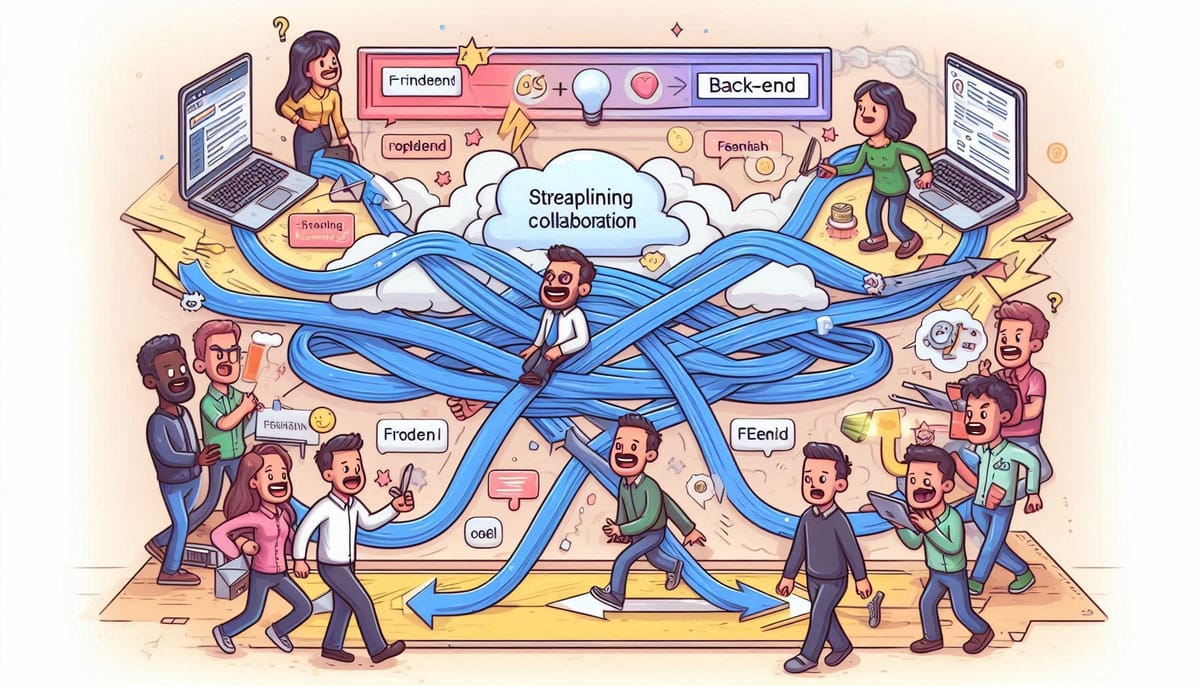Streamlining Collaboration: How Mirroring Frontend and Backend Teams Can Solve Coordination Challenges
We’ve hit a recurring pain point: delivering features often requires coordination across multiple frontend and backend teams, leading to delays, misalignment, and frustration. Here's what we're doing.

Introduction: The Problem We’re Solving
At our company, we run a platform that serves multiple customers, each with unique needs and requirements. Our frontend teams are tasked with delivering tailored experiences for these customers, while our backend teams manage the underlying services and APIs that power the platform. However, we’ve hit a recurring pain point: delivering features often requires coordination across multiple frontend and backend teams, leading to delays, misalignment, and frustration.
The challenge is compounded by the fact that our platform serves multiple customers. Merging frontend and backend teams into fully cross-functional teams doesn’t make sense in this context—each customer’s needs are distinct, and backend services often need to remain generalized to serve the entire platform. So, how do we strike the right balance between specialization and collaboration?
One solution we’re exploring is mirroring frontend and backend teams. This approach aligns backend teams closely with frontend teams, creating a one-to-one or one-to-few relationship between them. It’s not a full merge, but it’s a step toward reducing coordination overhead while maintaining the flexibility to serve multiple customers. Here’s how it works, why it might be the right fit for us, and how we can implement it effectively.
What Does Mirroring Look Like?
Mirroring involves structuring backend teams to align closely with frontend teams. Here’s what it looks like in practice:
- Each frontend team has a dedicated backend team (or a small number of backend teams) that it primarily works with.
- The backend team(s) focus on delivering the APIs, services, and data that the frontend team needs to build its features.
- The backend team(s) may still own specific services or domains, but their primary responsibility is to support the frontend team(s) they are aligned with.
For example, if we have a frontend team working on the checkout flow for Customer A, we’d have a dedicated backend team that owns the checkout service and payment APIs for that customer. Meanwhile, another backend team might support the user profile features for Customer B.
Why Mirroring Works for Us
- Reduced Coordination Overhead:
- Frontend teams only need to coordinate with their dedicated backend team(s), rather than multiple backend teams.
- This simplifies communication and decision-making, especially in a multi-customer environment.
- Stronger Alignment:
- Backend teams are incentivized to prioritize the needs of their aligned frontend team(s).
- This creates a shared sense of ownership and accountability for delivering features.
- Faster Iteration:
- Frontend teams can move faster because they have a dedicated backend team focused on their needs.
- This reduces delays caused by competing priorities across multiple backend teams.
- Clearer Boundaries:
- Each backend team has a well-defined scope of responsibility, reducing overlap and duplication of effort.
- Easier to Implement:
- Mirroring is less disruptive than merging teams or reorganizing around domains, as it preserves existing team structures to a large extent.
- Platform Modernization:
- By dedicating backend teams to frontend needs, the platform team can focus on modernizing the platform without being pulled into frontend-specific priorities.
- This reduces conflicts between frontend requirements and platform-wide improvements, allowing the platform team to innovate and evolve the underlying infrastructure.
- Empowered Product Managers:
- Product managers can work end-to-end within their aligned frontend and backend teams, ensuring a seamless flow from customer requirements to delivered features.
- At the same time, platform product managers can continue solving for the Platform-as-a-Service (PaaS) layer, ensuring the platform remains robust, scalable, and future-proof.
Challenges to Watch Out For
While mirroring offers many benefits, it’s not without its challenges:
- Risk of Silos: Backend teams may become too focused on their aligned frontend team(s), potentially losing sight of the broader system.
- Backend Team Overload: Supporting multiple frontend teams can create bottlenecks if priorities aren’t balanced effectively.
- Technical Debt: Short-term solutions to meet frontend needs may lead to long-term technical debt.
- Dependency Management: Shared services may still require coordination across teams, creating dependencies.
How We Can Implement Mirroring Effectively
To make mirroring work for our organization, we’ll need to:
- Define Clear Ownership:
- Assign each backend team to a specific frontend team or set of frontend teams.
- Clearly define the scope of responsibility for each backend team (e.g., specific services, APIs, or domains).
- Establish Strong Communication Channels:
- Act as One Team: Encourage frontend and backend teams to operate as a single unit in terms of communication. For example:
- Attend the same daily standups to share progress, blockers, and priorities.
- Hold joint sprint planning sessions to align on goals and deliverables.
- Conduct shared retrospectives to reflect on what’s working and what needs improvement.
- Use collaboration tools (e.g., Slack channels, shared documentation) to facilitate ongoing communication.
- Act as One Team: Encourage frontend and backend teams to operate as a single unit in terms of communication. For example:
- Adopt a "Contract-First" Approach:
- Define API contracts upfront to ensure frontend and backend teams can work independently once the contract is agreed upon.
- Use tools like OpenAPI/Swagger to document and version APIs.
- Balance Autonomy and Collaboration:
- Give backend teams autonomy to make technical decisions, but ensure they collaborate with other backend teams to maintain consistency across the system.
- Establish guilds or communities of practice for backend developers to share knowledge and align on best practices.
- Monitor and Adjust:
- Regularly assess the effectiveness of the mirrored structure.
- Be prepared to adjust team assignments or responsibilities as needed.
- Invest in Platform Teams:
- Introduce a platform team to handle shared backend concerns (e.g., infrastructure, authentication, logging).
- This reduces the burden on backend teams and ensures consistency across the system.
A Real-World Example
Imagine we have three frontend teams:
- Team A: Works on the checkout flow for Customer A.
- Team B: Works on user profiles for Customer B.
- Team C: Works on search and discovery for Customer C.
We could structure our backend teams as follows:
- Backend Team 1: Dedicated to Team A, owns the checkout service and payment APIs.
- Backend Team 2: Dedicated to Team B, owns the user service and profile APIs.
- Backend Team 3: Dedicated to Team C, owns the search service and recommendation APIs.
If there are shared services (e.g., authentication), a platform team could own those.
When Mirroring Makes Sense
Mirroring is particularly well-suited for organizations like ours, where:
- Multiple Customers Exist: Each customer has distinct needs, making full cross-functional teams impractical.
- Specialization is Required: Frontend teams require tailored backend support, but backend services need to remain generalized for the platform.
- Coordination Overhead is High: Delivering features requires frequent communication across multiple teams, leading to delays and inefficiencies.
- Platform Modernization is a Priority: The platform team needs the freedom to innovate without being bogged down by frontend-specific demands.
- Product Managers Need End-to-End Ownership: Product managers can focus on delivering customer value while platform product managers ensure the PaaS layer evolves to meet future needs.
Conclusion: Walking the Balance
Mirroring frontend and backend teams isn’t a silver bullet, but it’s a pragmatic approach to solving the coordination challenges we face. By aligning backend teams closely with frontend teams, we can streamline communication, accelerate delivery, and maintain clear ownership—all while preserving the flexibility to serve multiple customers.
This approach also allows the platform team to focus on modernizing the platform without being pulled into frontend-specific priorities, ensuring the platform remains robust and future-proof. At the same time, product managers can work end-to-end within their aligned teams, delivering customer value efficiently, while platform product managers continue solving for the PaaS layer, ensuring the platform evolves to meet broader business goals.
In a world where specialization and collaboration often feel at odds, mirroring offers a way to walk the balance. It’s not about merging teams or sacrificing flexibility—it’s about creating the right structure to deliver value efficiently and effectively.




